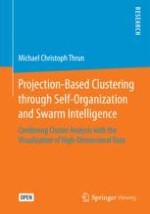This book is published open access under a CC BY 4.0 license.
It covers aspects of unsupervised machine learning used for knowledge discovery in data science and introduces a data-driven approach to cluster analysis, the Databionic swarm (DBS). DBS consists of the 3D landscape visualization and clustering of data. The 3D landscape enables 3D printing of high-dimensional data structures. The clustering and number of clusters or an absence of cluster structure are verified by the 3D landscape at a glance. DBS is the first swarm-based technique that shows emergent properties while exploiting concepts of swarm intelligence, self-organization and the Nash equilibrium concept from game theory. It results in the elimination of a global objective function and the setting of parameters. By downloading the R package DBS can be applied to data drawn from diverse research fields and used even by non-professionals in the field of data mining.
